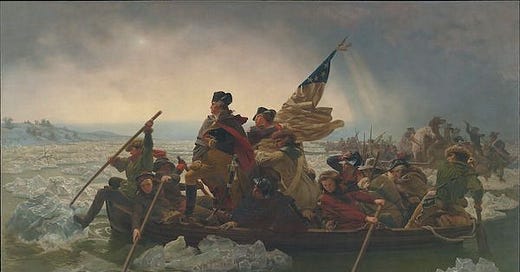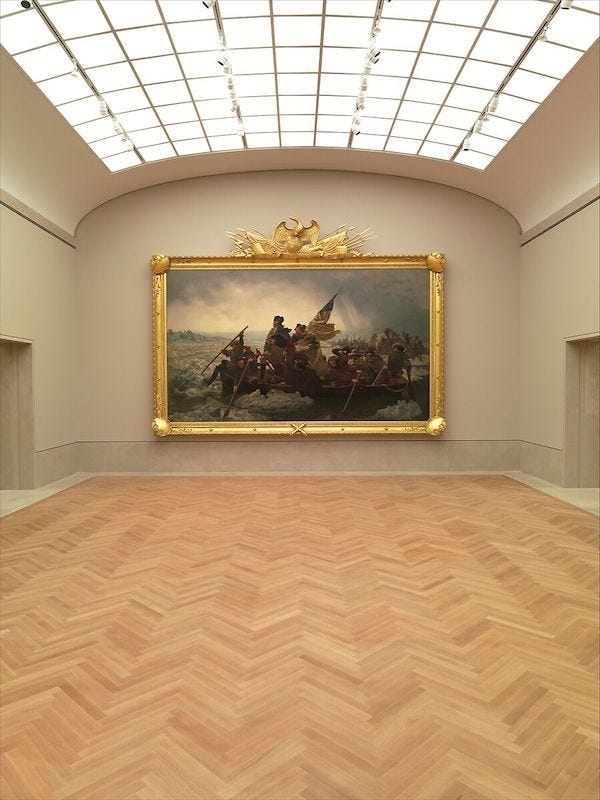The Wisdom of 'Washington Crossing the Delaware'
plus meat sticks and a visit to Hungary's McDonald's nightclub
Dear Friends,
Welcome back to The Crunchwrap, Substack’s one surviving Taco Bell-themed newsletter. (Rest in Picante, Taco Bell Quarterly.)
Sorry for not writing sooner. This past month I made it to Boston, Budapest, and Croatia to work on some exciting things and, more importantly, to take some time off. You don’t have to say it back, but I’ve missed you.
In this Crunchwrap, we’ll be talking about patriotic art, meat sticks and the American proteinaissance, and the scourge of chain barbecue. But first…
If you’re a new subscriber (hey), here’s a little bit about me and this newsletter: I’m Adam Chandler, a journalist based in New York. I write for a bunch of places about politics, culture, work, fast food, business, regular-speed food, Americana, and more. I’m also the author of two books, including Drive-Thru Dreams (2019) and 99% Perspiration which, in spite of some really bad Ben Franklin jokes, came out earlier this year to wide acclaim. (You might also know me from some unwieldy hand-talking on The History Channel’s The Food That Built America.)
In this newsletter, I cover Critical National Issues like waning social cohesion in America, Taco Bell’s collaborations Cheez-It and Milk Bar, and the relative grossness of Trader Joe’s product recalls. I welcome your responses and notes and might publish them if they’re funny, insightful, or not mean.
First Crunch
Early this week, I celebrated my birthday in part by taking a trip to Pastrami Queen, Central Park, and the Metropolitan Museum of Art. I was joined by Ben Smith, The Crunchwrap’s Gaming Commissioner.
Like most people, visiting art museums always makes me feel better than everyone else. But the thought of spending my birthday at one??? Irresistible. A perfect storm of joy, self-satisfaction, and performative virtue.
For a hopeless/hapless American romantic like me, no trip to the Met is complete without a stop by Emanuel Leutze’s Washington Crossing the Delaware, the iconic, patriotic, endlessly reproduced centerpiece of the American Wing. You know the painting: George Washington heroically posed on a rowboat leading troops across an ice-chunked river on Christmas night, 1776. It’s colossal in person though (21’ x 12’), and seeing it IRL is pretty humbling.
For a work that stirs so much simplistic blood, the particulars are a bit more complicated. To start, the painting was actually created at Leutze’s studio in Düsseldorf about 75 years after the crossing. Smug historians note that the point at the Delaware where Washington crossed is way too narrow and suggest that Leutze used the Rhine River as inspiration.
The dramatic rendering of the river isn’t the only bit of artistic license that Leutze took; there are the boats (too small) and the presence of James Monroe beside Washington (he crossed in a different boat) as well as the stars-and-stripes that Monroe is clutching (the design of which hadn’t been adopted yet).
Of course, nobody likes a pedant or a nitpick and so historians have also regularly cast about for theories of Luetze’s motivation in making the painting at all. Notably, Washington’s boat features a Black soldier at his knee (with some suggesting Luetze’s abolitionist leanings), an androgynous rower at his heel in a red shirt (suggested by some to be a woman), a Scottish immigrant in a Balmoral bonnet, and a rower at the back in deerskin leggings (suggested by some to be a Native American).
I’m obviously a sucker for this expansive interpretation, which would be considered radical in some corners today. I spend a fair bit of time in my new book exploring the idea of the American Revolution (as well as the creation of the Constitution and most other landmark national moments) as a feat achieved by very different people who broadly disagreed with and distrusted each other. The last bit of hope I’m clinging to these days is the truth that Americans have always been deeply divided.
But in the case of Washington Crossing the Delaware, what I also like about the history is how it reflects the global influence of the American Revolution. The painting depicts the Continental Army crossing the river to launch a sneak attack not on the British, but on a bunch of Hessian troops in Trenton, New Jersey, in what turned out to be an early major point in the war. As I also note in my book, the 30,000 Hessian troops who fought for the British during the Revolution weren’t mercenaries in the sense that they personally profited from the war. The Hessians were contracted by German states that controlled their lives.
It’s important to consider that Emanuel Leutze painted Washington Crossing the Delaware in Germany, in the immediate aftermath of the German Revolutions of 1848-1849 – uprisings that were spurred by an anti-monarchial mood similar in spirit to the many revolutions that followed American independence. I have no idea if Leutze knew that the Hessians were the ones who got got on the other side of the river. But the idea that the ragtag Continental Army was actually on its way to fight a symbol of cruel German imperialism gives the painting another little spiritual flourish.
Not surprisingly, the folks at the Met offer a different read of Washington Crossing the Delaware for our current climate. Quoting Scott Manning Stevens, a cultural historian and Akwesasne Mohawk, a small placard beside the painting notes: “Leutze wants to paint our better angels. He shows this democratic vision towards freedom—that it’s not just Washington alone.”
Shameless Plug
TOMORROW, I’m joining the live broadcast of Boston Public Radio (WGBH) from 1-1:30 PM ET to talk about 99% Perspiration and Alex Bregman and hear stories from callers about their lives and work. You don’t have to an “r” to the end of “pizza” to listen in.
I also recently joined Bob McKinnon at NPR’s Attribution to talk about my book and how work and worthiness are intertwined in American life. The podcast is about social mobility and community and, the conversation felt important, especially given that Congress is working to gut the social safety net to (not even) offset tax cuts for the ultra wealthy. The episode is here, but I’ve also included a little clip below:
Keeping with my
maniaswings between darkness and light, I also wrote a piece about the unlikely rise of meat sticks as a symbol of America’s current obsessions with protein, functional food, and even clean eating. It’s a weirdly fascinating trend and I’m particularly grateful for the kind editor at Sherwood for NOT cutting “make ends meat” out of the copy.Lastly, while traveling last month, I visited the McDonald’s in Budapest that (somewhat) famously turns into a nightclub after hours on the weekend. I have a slightly unhinged breakdown of the entire scene here on Instagram, but I’ve added a lil taste of what the chaos looked like below:
Nu, what else?
I’m extremely late to this party, but I just read Gabrielle Zevin’s novel Tomorrow and Tomorrow and Tomorrow about life, video games, and platonic friendship, and I highly recommend it!
Have you been avoiding chain barbecue restaurants all your life? Please be vindicated by this searing exposé of Dickey’s BBQ (gift link) by Brett Anderson, which is full of bonkers details.
New Yorkers: If you’re down for something offbeat (an absurdist show with an unnerving amount of audience participation), I loved Julia Masli’s Ha Ha Ha Ha Ha Ha Ha. It’s playing through June 22 at The Public and tickets are $30 with the code “HAHAHEHE”
Ok friends, that it’s for this week! Did you like this weird digression into U.S. Art History or did it bore you to tears? Let me know.
And, as always, thank you for reading.
With love,
Adam








